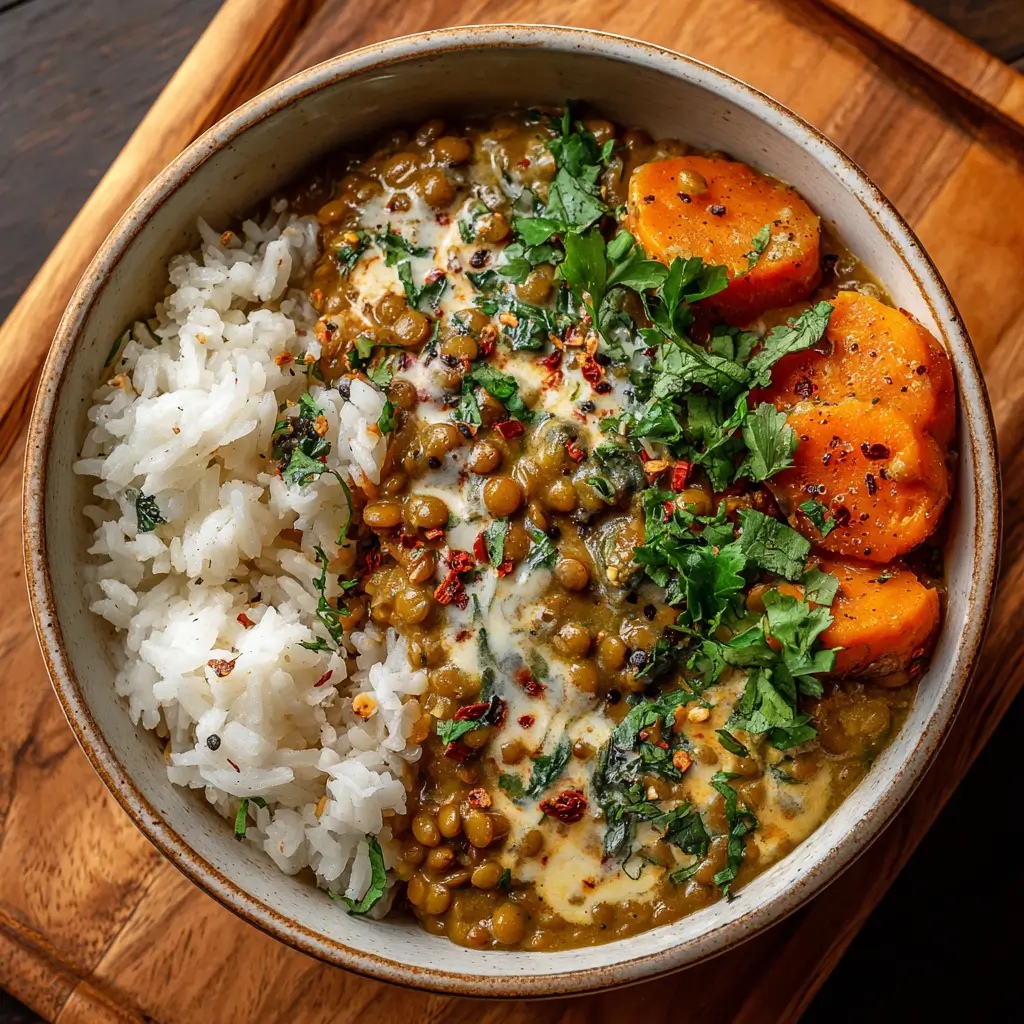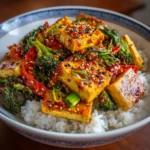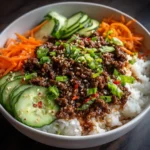Creamy Coconut Lentil Curry: A Comforting, Flavor-Packed Vegan Delight
If you’re searching for a hearty, nutritious, and deeply satisfying meal that’s both easy to prepare and rich in flavor, look no further than Creamy Coconut Lentil Curry. This aromatic dish blends earthy lentils with the luxurious richness of coconut milk, creating a velvety stew that warms the soul and nourishes the body. Whether you’re an experienced home cook or just beginning your culinary journey, this plant-based curry is a versatile staple that adapts beautifully to different tastes and dietary needs. From its humble roots in South Asian kitchens to its modern-day popularity across global tables, this recipe bridges tradition and innovation—offering comfort, wellness, and bold taste in every spoonful.
The History of Lentil Curries and Coconut-Based Stews
Lentils have been a dietary cornerstone in many cultures for thousands of years, especially in India, the Middle East, and parts of Africa. In Indian cuisine, lentils—known as dal—are central to daily meals, often simmered with spices, aromatics, and herbs into soups, stews, or side dishes. The use of coconut in curries originated primarily in the tropical coastal regions of southern India—such as Kerala, Tamil Nadu, and Karnataka—where coconut palms grow abundantly. These areas developed unique culinary traditions that incorporate fresh coconut, coconut oil, and coconut milk into savory dishes.
Over centuries, the combination of lentils and coconut evolved into creamy, spiced curries enjoyed during festivals, family gatherings, and everyday meals. As trade routes expanded and global migration increased, these regional specialties traveled far beyond their origins. Today, Creamy Coconut Lentil Curry has become a beloved feature in vegetarian and vegan diets worldwide, appreciated not only for its deliciousness but also for its nutritional density and environmental sustainability. Modern adaptations often include influences from Thai, Caribbean, and East African cuisines, all of which use coconut milk and legumes in their traditional cooking.
Ingredients Breakdown: What Makes This Curry So Rich and Nutritious?
The magic of Creamy Coconut Lentil Curry lies in its thoughtfully chosen ingredients, each contributing to flavor, texture, and health benefits. Here’s a detailed breakdown of the key components:
- Lentils: Typically red or yellow lentils are used because they cook quickly and break down into a creamy consistency. They’re packed with protein, fiber, iron, and folate—making them ideal for heart health and sustained energy.
- Coconut Milk: Full-fat canned coconut milk gives the curry its signature creaminess and subtle sweetness. It contains medium-chain triglycerides (MCTs), which may support metabolism and satiety.
- Onion, Garlic, and Ginger: These aromatic foundations build depth and complexity. Garlic and ginger also offer anti-inflammatory and immune-boosting properties.
- Tomatoes: Fresh or canned tomatoes add acidity and brightness, balancing the richness of the coconut while contributing lycopene, a powerful antioxidant.
- Spices: Turmeric brings earthy warmth and potent anti-inflammatory compounds like curcumin; cumin and coriander seeds provide smoky and citrusy notes; mustard seeds and fenugreek enhance aroma; chili flakes or fresh chilies bring heat. All spices work synergistically to stimulate digestion and enhance nutrient absorption.
- Fresh Herbs: Cilantro adds a refreshing finish, while curry leaves (if available) impart a distinctive, slightly nutty fragrance typical of South Indian cooking.
- Oil: Coconut oil or vegetable oil is used for tempering spices, releasing their essential oils and intensifying flavor.
- Vegetable Broth or Water: Used to adjust consistency and help the lentils cook evenly without sticking.
Optional additions might include spinach, sweet potatoes, bell peppers, or chickpeas for added texture and nutrients.
Step-by-Step Recipe: How to Make Creamy Coconut Lentil Curry at Home
This foolproof method ensures a perfectly balanced, luxuriously smooth curry every time. Follow these steps carefully for restaurant-quality results in your own kitchen.
- Rinse the Lentils: Place 1 cup of red or yellow lentils in a fine-mesh sieve and rinse thoroughly under cold water until the water runs clear. This removes any dust or debris and prevents foaming during cooking.
- Sauté the Aromatics: Heat 2 tablespoons of coconut oil in a large pot or Dutch oven over medium heat. Add 1 chopped onion and sauté for 5–7 minutes until translucent and lightly golden. Stir in 3 minced garlic cloves and 1 tablespoon of grated fresh ginger, cooking for another minute until fragrant.
- Bloom the Spices: Add 1 teaspoon ground turmeric, 1 teaspoon ground cumin, 1 teaspoon ground coriander, ½ teaspoon chili powder (adjust to taste), and a pinch of salt. Stir constantly for about 30 seconds to toast the spices—this step unlocks their full flavor potential.
- Add Tomatoes: Stir in 1 cup of diced tomatoes (fresh or canned). Cook for 4–5 minutes, allowing the mixture to thicken slightly and the flavors to meld.
- Cook the Lentils: Add the rinsed lentils along with 3 cups of vegetable broth or water. Bring to a gentle boil, then reduce the heat to low, cover, and simmer for 18–22 minutes, stirring occasionally, until the lentils are soft and mushy.
- Incorporate Coconut Milk: Pour in 1 can (13.5 oz) of full-fat coconut milk. Stir well to combine and let the curry simmer uncovered for another 10–15 minutes to develop richness and allow the sauce to thicken. If the curry becomes too thick, add more broth or water to reach your desired consistency.
- Season and Finish: Taste and adjust seasoning with salt, pepper, and a squeeze of fresh lime juice. Stir in a handful of chopped cilantro just before serving. For an authentic touch, heat 1 teaspoon of mustard seeds in 1 tablespoon of oil until they pop, then pour this tempering (called tadka) over the finished curry.
- Serve Warm: Ladle the curry into bowls and serve alongside basmati rice, naan bread, quinoa, or roasted vegetables.
Tips for Perfecting Your Creamy Coconut Lentil Curry
- Use Full-Fat Coconut Milk: Light coconut milk will result in a thinner, less creamy curry. Shake the can well before opening, or blend it briefly if separation occurs.
- Don’t Skip Blooming the Spices: Toasting spices in oil releases volatile compounds that dramatically enhance flavor. Be careful not to burn them—keep the heat moderate.
- Simmer Gently: Avoid boiling vigorously after adding coconut milk, as it can cause the milk to separate or become oily.
- Balance Acidity: A splash of lemon or lime juice at the end brightens the entire dish and cuts through the richness.
- Let It Rest: Like most curries, this dish tastes even better the next day as the flavors continue to deepen and harmonize.
- Watch the Salt: Since coconut milk and broth can vary in sodium content, season gradually and taste as you go.
- Prevent Sticking: Stir frequently during the initial lentil-cooking phase, especially if using a thinner pot. A heavy-bottomed pan works best.
Variations and Customizations: Make It Your Own
One of the greatest strengths of this recipe is its adaptability. Feel free to experiment based on what you have on hand or your personal preferences:
- Protein Boost: Add cooked chickpeas, tofu cubes, or tempeh for extra protein and texture.
- Vegetable Add-Ins: Fold in chopped spinach, kale, zucchini, cauliflower, or diced sweet potatoes during the last 10 minutes of cooking.
- Spice Level: Control the heat by adjusting the amount of chili powder, adding fresh green chilies, or including a dash of cayenne. For mild versions, omit chilies altogether.
- Gluten-Free Option: Naturally gluten-free, this curry is safe for those with celiac disease or gluten sensitivity—just ensure your broth is certified GF.
- Oil-Free Version: Sauté aromatics in water or vegetable broth instead of oil for a lower-fat, whole-foods approach.
- Curry Leaf Magic: If you can find fresh or dried curry leaves, add 6–8 leaves during the sauté stage for an authentic South Indian essence.
- Dairy Twist: While traditionally vegan, some prefer stirring in a spoonful of plain yogurt at the end for tanginess and creaminess.
- International Flair: Infuse Thai flavors with lemongrass, kaffir lime leaves, and red curry paste. Or go Caribbean-style with allspice, thyme, and scotch bonnet pepper.
Health Considerations and Nutritional Value
Creamy Coconut Lentil Curry isn’t just delicious—it’s a powerhouse of nutrition that supports overall wellness. Let’s explore its health benefits and considerations:
- High in Plant-Based Protein: One serving provides approximately 15–18 grams of protein from lentils alone, making it excellent for vegetarians, vegans, and anyone reducing meat intake.
- Fiber-Rich: With around 12–15 grams of dietary fiber per serving, this curry promotes digestive health, stabilizes blood sugar, and increases satiety, aiding in weight management.
- Heart-Healthy Fats: Though coconut milk is high in saturated fat, emerging research suggests that the type found in coconuts (mainly lauric acid) may have neutral or even beneficial effects on cholesterol when consumed in moderation as part of a balanced diet.
- Anti-Inflammatory Properties: Turmeric (especially when paired with black pepper, which enhances curcumin absorption) has strong anti-inflammatory and antioxidant effects linked to reduced risk of chronic diseases.
- Low Glycemic Index: Thanks to its high fiber and protein content, this curry has a minimal impact on blood sugar levels, making it suitable for people with type 2 diabetes.
- Rich in Vitamins and Minerals: Lentils contribute iron, magnesium, potassium, and B vitamins, while coconut milk offers manganese and copper. Tomatoes provide vitamin C and lycopene.
- Calorie Consideration: Depending on the amount of coconut milk used, a serving may range between 300–450 calories. To lighten it up, use light coconut milk or dilute full-fat with extra broth.
- Allergen Information: This recipe is naturally free of dairy, eggs, nuts (unless coconut is considered a concern), soy (if broth is soy-free), and gluten. Always check labels on packaged ingredients if allergies are a concern.
Full Ingredient List
- 1 cup red or yellow lentils, rinsed and drained
- 2 tablespoons coconut oil (or olive/vegetable oil)
- 1 medium onion, finely chopped
- 3 garlic cloves, minced
- 1 tablespoon fresh ginger, grated
- 1 cup diced tomatoes (canned or fresh)
- 1 teaspoon ground turmeric
- 1 teaspoon ground cumin
- 1 teaspoon ground coriander
- ½ teaspoon chili powder (or to taste)
- ¼ teaspoon ground cinnamon (optional, for warmth)
- Pinch of cayenne pepper (optional, for heat)
- 3 cups vegetable broth or water
- 1 (13.5 oz) can full-fat coconut milk
- 1 teaspoon salt (adjust to taste)
- Freshly ground black pepper, to taste
- 1–2 tablespoons fresh lime juice
- ½ cup fresh cilantro, chopped
- For tempering (optional): 1 tsp mustard seeds, ¼ tsp fenugreek seeds, 1 dried red chili, 5–6 curry leaves, 1 tbsp oil
Detailed Directions
- Prepare Ingredients: Rinse lentils thoroughly. Chop onion, mince garlic, grate ginger, dice tomatoes if using fresh, and measure out all spices.
- Sauté Onion: In a large pot or deep skillet, heat coconut oil over medium heat. Add chopped onion and cook for 5–7 minutes, stirring occasionally, until soft and golden.
- Add Garlic and Ginger: Stir in garlic and ginger. Cook for 1 minute until fragrant, being careful not to burn.
- Bloom Spices: Add turmeric, cumin, coriander, chili powder, cinnamon, and cayenne. Stir continuously for 30 seconds to release essential oils.
- Add Tomatoes: Stir in tomatoes and cook for 4–5 minutes until softened and the mixture begins to thicken.
- Add Lentils and Liquid: Add rinsed lentils and vegetable broth. Stir well, increase heat to bring to a boil, then reduce to a simmer. Cover and cook for 18–22 minutes, stirring occasionally, until lentils are tender and breaking apart.
- Stir in Coconut Milk: Uncover, pour in coconut milk, and stir to combine. Simmer gently for 10–15 minutes to thicken and infuse flavors. Adjust consistency with more broth if needed.
- Season: Add salt, pepper, and lime juice. Stir in chopped cilantro.
- Optional Tempering (Tadka): In a small pan, heat 1 tablespoon oil. Add mustard seeds and let them pop. Add fenugreek seeds, dried chili, and curry leaves. Fry for 30 seconds until fragrant. Pour this sizzling mixture over the curry.
- Serve: Serve hot with basmati rice, jeera rice, roti, naan, or quinoa. Garnish with extra cilantro or a dollop of vegan yogurt if desired.
Frequently Asked Questions (FAQ)
Can I use green or brown lentils instead of red?
Yes, but they take longer to cook and retain more shape. Red and yellow lentils are preferred for a creamy texture.
How do I store leftovers?
Cool completely and store in an airtight container in the refrigerator for up to 5 days or freeze for up to 3 months. Reheat on the stove with a splash of water or broth.
Can I make this in a slow cooker or Instant Pot?
Absolutely! In a slow cooker: combine all ingredients except cilantro and lime, cook on low 6–8 hours or high 3–4 hours. In an Instant Pot: use Saute function for aromatics, then pressure cook on High for 8 minutes with quick release.
Is this curry spicy?
It’s mildly spicy by default. You can easily adjust the heat level by increasing or decreasing chili powder or adding fresh peppers.
Why did my coconut milk separate?
This usually happens due to high heat or acidic ingredients. Simmer gently and avoid rapid boiling after adding coconut milk.
Can I make it nut-free?
Yes. Despite its name, coconut is botanically a fruit, not a tree nut. However, consult a healthcare provider if there’s a known coconut allergy.
What can I serve with this curry?
Excellent pairings include steamed basmati rice, jasmine rice, naan, chapati, pita bread, or a simple cucumber salad.
Can I use canned lentils?
You can, but dried lentils yield better texture and flavor control. If using canned, drain and rinse them, then add at the end just to warm through.
Summary
Creamy Coconut Lentil Curry is a nourishing, flavorful, and adaptable vegan dish that combines protein-rich lentils with luscious coconut milk and warming spices for a meal that’s as healthy as it is delicious. Easy to customize and perfect for weeknight dinners or meal prep, this curry brings global inspiration to your kitchen with every comforting bite.










